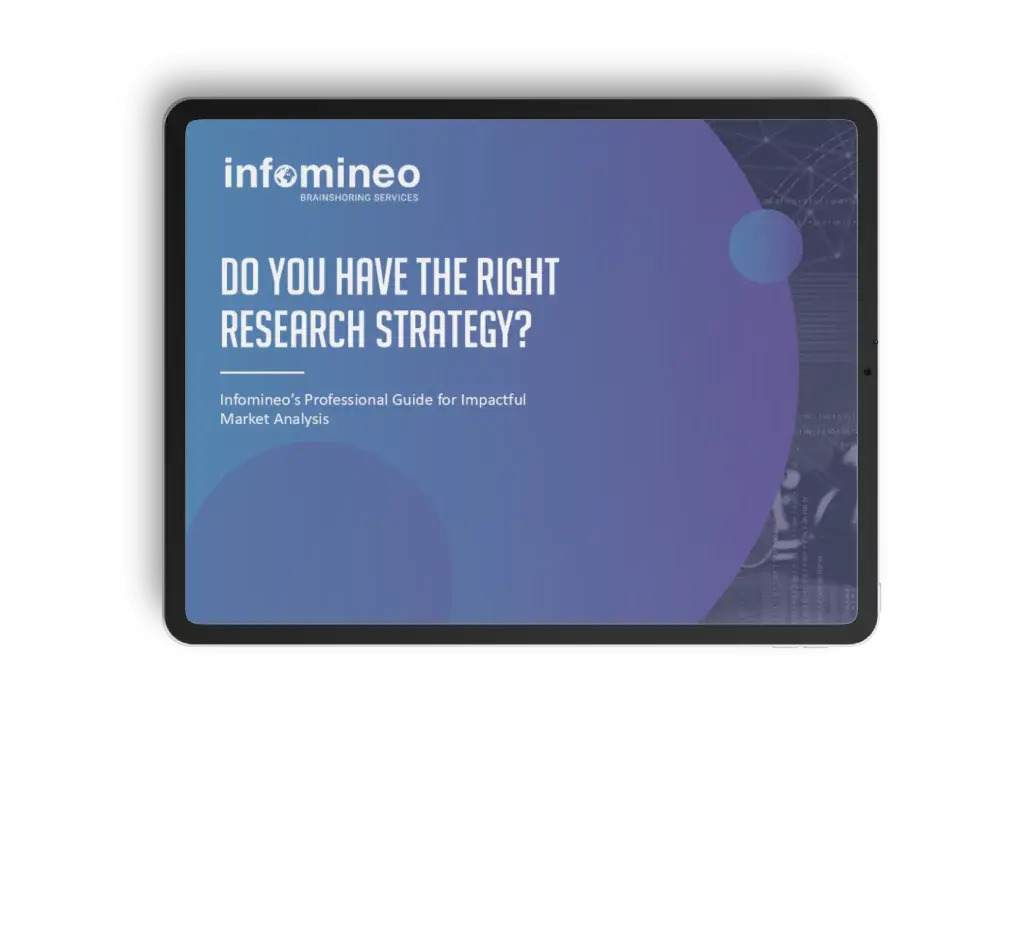Market Research Services: Key Strategies for Consultancy

Table of Contents
Market research has long been a foundational pillar of consulting work, critical to framing client challenges, validating strategic assumptions, and informing high-stakes decisions. As consulting firms expand their mandates across geographies, industries, and functions, the demand for timely, tailored, and methodologically sound research continues to grow.
This article outlines how market research services create value across the consulting lifecycle. It explores the distinct roles of primary and secondary research, their application in use cases, and the key steps required to execute research with rigor. It also highlights the capabilities firms need to build internally, the evolving trends reshaping research delivery, and real-world case studies demonstrating how insights are generated in practice.
Types of Market Research Services Powering Consulting Engagements
Consulting firms leverage primary and secondary research to deliver tailored insights. Selecting the right research approach is essential to balancing depth, efficiency, and reliability across client engagements.
Primary Research for First-Hand Perspectives
Primary research involves collecting data directly from the source to address specific client objectives. It is particularly valuable when publicly available information is limited or lacks the necessary depth. Key primary research methods include:
Expert Interviews
Mobile Surveys
Focus Groups
Mystery Shopping
For additional primary research techniques and when to use them, explore our guide: Primary Research Methods: When to Use Qualitative vs. Quantitative
Secondary Research for Context and Scale
Secondary research draws on pre-existing sources such as reports, databases, and national statistics to deliver strategic insights. It enables consulting teams to assess trends, validate assumptions, and build a comprehensive understanding of the market landscape. Examples of secondary sources include:
Databases
Official Governmental Sources
Industry Reports
News Publications
Strategic Applications of Market Research Services
Market research is a strategic enabler across the consulting value chain. From evaluating new market opportunities to shaping product design, mitigating risks, or supporting M&A due diligence, research informs decisions where the stakes are highest. The following use cases illustrate how consultancies turn insights into competitive advantage.
Market Entry and Expansion
Entering new markets involves considerable financial and operational risk. Market research enables firms to assess demand potential, evaluate regulatory environments, and understand the competitive landscape, providing a robust foundation for decision-making. Key focus areas typically include:
Product and Service Development
Bringing new offerings to market requires alignment with customer needs and expectations. Research helps determine feature prioritization, optimal pricing strategies, and positioning approaches based on credible market evidence. Consultancies often rely on market research for:
Risk Monitoring and Scenario Planning
Operational continuity and resilience depend on anticipating risks across regulatory, economic, and technological domains. Market research supports early detection of external threats and facilitates the development of structured mitigation strategies. Typical research contributions in this area include:
M&A Due Diligence
Merger and acquisition decisions require more than financial modeling. Market research validates assumptions about target companies, industry trajectories, and customer bases, contributing to accurate valuation and post-deal integration planning. Research adds value by helping in:
Supply Chain Management
Global supply chains face rising complexity and exposure to macroeconomic volatility. Research helps organizations build resilient networks by assessing sourcing options, cost structures, and logistical constraints. Research can support supply chain strategy by:
Brand and Customer Perception Analysis
Strategic brand positioning hinges on understanding how stakeholders perceive value, differentiation, and trust. Research captures sentiment, uncovers gaps in perception, and identifies brand equity drivers across segments. Key research activities include:
Driving Research Excellence: Processes and Capabilities that Deliver Impact
High-quality research depends not only on the data collected but on the rigor of the process and the expertise of the team. From defining the right question to deploying the right tools and translating outputs into action, success requires structure, skill, and strategic alignment.
Six Steps to Deliver Insightful Market Research
A structured research process is essential to delivering insights that are accurate, relevant, and decision-ready. The following six steps outline how to design and execute market research engagements:
Identify Client Objectives
Align on Scope and Deliverables
Select the Right Methodology
Collect the Data
Synthesize Insights
Present Insights to the Client
Skills That Power High-Impact Market Research
To deliver research that informs high-stakes decisions, professionals must possess a blend of analytical, technical, and business-oriented capabilities. Research teams must go beyond data collection to contextualize findings and align them with client objectives. Key skills they need include:
Analytical and Critical Thinking
- Distilling large volumes of data into clear, actionable insights
- Identifying patterns, correlations, and anomalies
- Being comfortable with ambiguity and synthesizing complex information into concise conclusions
Research and Methodology Expertise
- Mastering both qualitative and quantitative techniques
- Being proficient across multiple sources and quality assurance standards
- Understanding sampling methods, bias mitigation, and research ethics
Business Acumen and Industry Awareness
- Comprehending client industries, including their value chains and regulatory contexts
- Assessing market, regulatory, and macroeconomic forces that influence client strategy
- Linking research findings to business implications and strategic levers
Clear Communication Skills
- Translating complex findings into concise, stakeholder-friendly narratives
- Tailoring messaging to technical and non-technical audiences
- Presenting insights in structured formats that drive decision-making
Emerging Trends in Market Research Services
As client expectations rise and markets evolve, research practices must also advance. Modern technologies, data sources, and delivery models are reshaping how insights are produced and consumed. Understanding these trends is critical for research teams looking to remain relevant, responsive, and impactful.
AI-Augmented Research
The integration of artificial intelligence into research workflows is transforming how insights are generated, enhancing efficiency and scale. From automating repetitive tasks to generating insights, AI is redefining research capabilities. Key applications of AI in market research include:
Real-Time and Continuous Insight Cycles
Speed and adaptability have become competitive imperatives. To meet these requirements, research teams are adopting tools and approaches such as:
Sustainability, ESG, and Ethical Metrics as Core KPIs
Environmental and ethical dimensions are now fundamental to strategic research. Market leaders are embedding ESG into their research processes by:
Adaptive, On-Demand Research Models
Traditional project-based research models are giving way to more flexible, scalable, and client-driven structures. Leading firms are embracing models that enable:
Case Studies: How Consultants Leverage Infomineo
Infomineo partners with leading consultancies to deliver research that supports decisions across industries, functions, and regions. The following examples showcase how our structured methodologies, domain expertise, and rigorous validation processes deliver insights that go beyond data to drive tangible impact.
Monitoring the Cybersecurity Market in the Middle East

A global professional services firm engaged Infomineo to map the evolving cybersecurity landscape with a focus on the Middle East. Leveraging a combination of industry trackers, premium news aggregators, and targeted expert interviews, we provided an integrated view of key market developments. The resulting intelligence helped the client contextualize regional activity within global trends, assess competitor positioning, and inform service strategy in a complex, fast-changing domain.
Profiling the Tourism Sector Across Geographies

To support a global consultancy’s effort to refresh national tourism profiles, Infomineo conducted structured desk research using official government portals, policy documents, and verified third-party sources. Within a six-week timeframe, we delivered updated and newly developed country profiles, each including tourism KPIs, strategic plans, institutional structures, and macroeconomic linkages. Our coordination framework ensured seamless delivery and alignment with the client’s reporting standards.
Benchmarking Classic Car Museums in GCC

A consultancy required a comparative analysis of classic car museums across the GCC, covering regulatory, commercial, and operational dimensions. Infomineo executed a multi-layered research approach, combining local-language secondary sources with targeted stakeholder insights. The output included performance benchmarking across nine museums, regulatory frameworks in three key markets, and comparative intelligence on international museums, maintenance networks, and ownership economics.
Navigating Industries Through In-Depth Market Reports

Infomineo was commissioned to deliver market overviews across niche manufacturing verticals, including mold manufacturing, die-cast tooling, CNC machinery, aluminum furnaces, and robotics. By applying a structured research methodology and mining sector-specific publications, industry reports, and institutional databases, we built a portfolio of in-depth market summaries. Each report included company intelligence, trend analysis, and direct source references to support high-stakes strategic planning.
Explore more insightful case studies on consultancies.
Infomineo’s Market Research Services: From Data to Decision
Infomineo delivers end-to-end market research solutions that combine deep secondary research expertise with strategically managed primary research. Our teams source, validate, and synthesize insights from the most relevant databases, publications, and institutional sources, while also designing and overseeing targeted primary studies through expert interviews, mobile surveys, focus groups, and more.
Each project is enhanced through our proprietary AI orchestrator, B.R.A.I.N.™, which supports faster synthesis and deeper insight generation, while remaining guided by professionals trained to maximize AI’s potential. This human-AI synergy ensures rigorous methodologies, robust quality control, and insights that align precisely with client objectives.
FAQ (frequently asked questions)
What are market research services?
Market research services involve gathering, analyzing, and interpreting data to support strategic business decisions. For consulting firms, these services provide critical insight into industry dynamics, competitor positioning, customer behavior, and more, to ensure recommendations are evidence-based and contextually grounded.
What are the main types of market research?
Market research relies on two main approaches: primary and secondary research. Primary research collects original data through methods like expert interviews, mobile surveys, focus groups, and mystery shopping, ideal for addressing specific client questions. Secondary research uses existing sources such as databases, government publications, industry reports, and news outlets to provide broader market context and validation. Combined, they offer a balanced view of both tailored insights and scalable intelligence.
What are the six steps involved in market research?
Market research begins by identifying the client’s core objectives and understanding the decision the research needs to support. Next, the team aligns on scope, geographies, and expected deliverables. Once the framework is clear, the right combination of research tools and sources is selected, balancing primary and secondary methods. Data is then collected through validated approaches, synthesized into key insights, and contextualized to align with the client’s strategic goals. The final step is presenting findings in a clear, actionable format that supports informed decision-making.
What are the latest trends in market research services?
Modern market research is being reshaped by advancements in AI, growing demands for speed, and the need for deeper strategic relevance. Key trends include the use of AI to accelerate data processing and generate synthetic datasets, the shift toward real-time and continuous insight cycles, and the integration of ESG and sustainability metrics into core research KPIs. Additionally, traditional project-based models are being replaced by adaptive, on-demand research models that offer greater flexibility and scalability for evolving client needs.
What skills do market researchers need?
Effective market researchers combine analytical thinking, methodological expertise, clear communication, and strong business acumen. They must extract insights from complex data, apply robust qualitative and quantitative methods, and ensure the use of credible sources. Strong communication skills are essential to convey findings clearly to diverse stakeholders. Equally, a solid understanding of industry dynamics and external market forces enables them to link research to real business impact.
To Wrap Up
In the consulting world, market research plays a central role in delivering client impact. It enables firms to scope opportunities, benchmark performance, assess risks, and design strategies rooted in real-world dynamics. Primary and secondary research methods allow consultants to generate intelligence beyond data points to support clear, defensible recommendations.
However, extracting value from research depends on more than methodology. It requires structured workflows, skilled analysts, and a deep understanding of both the client’s strategic context and the industry landscape. As market dynamics evolve and expectations rise, consultancies must invest in research excellence, adapting delivery models, upskilling teams, and leveraging emerging tools to ensure insights remain timely, relevant, and actionable. With the right approach, market research drives long-term client success.
